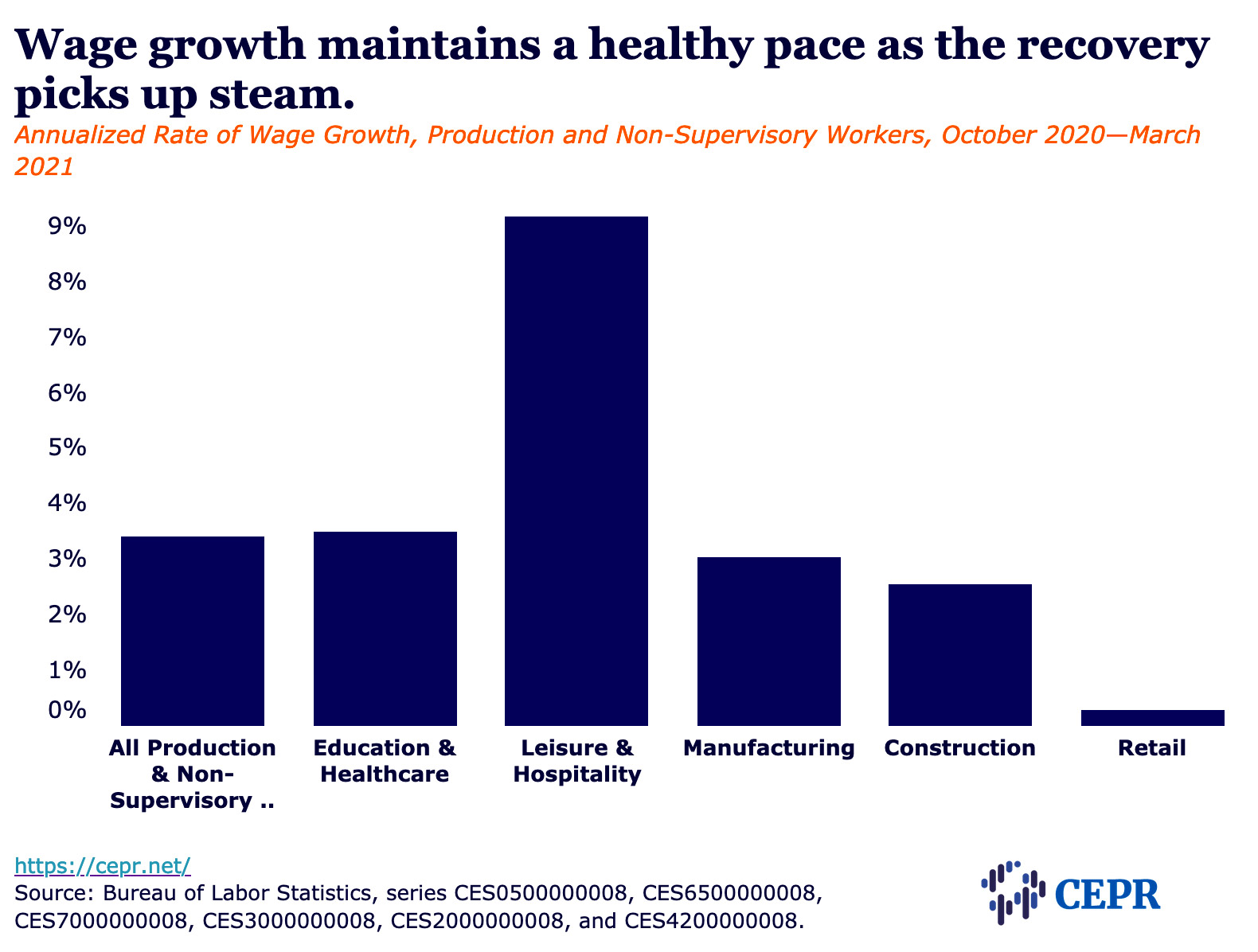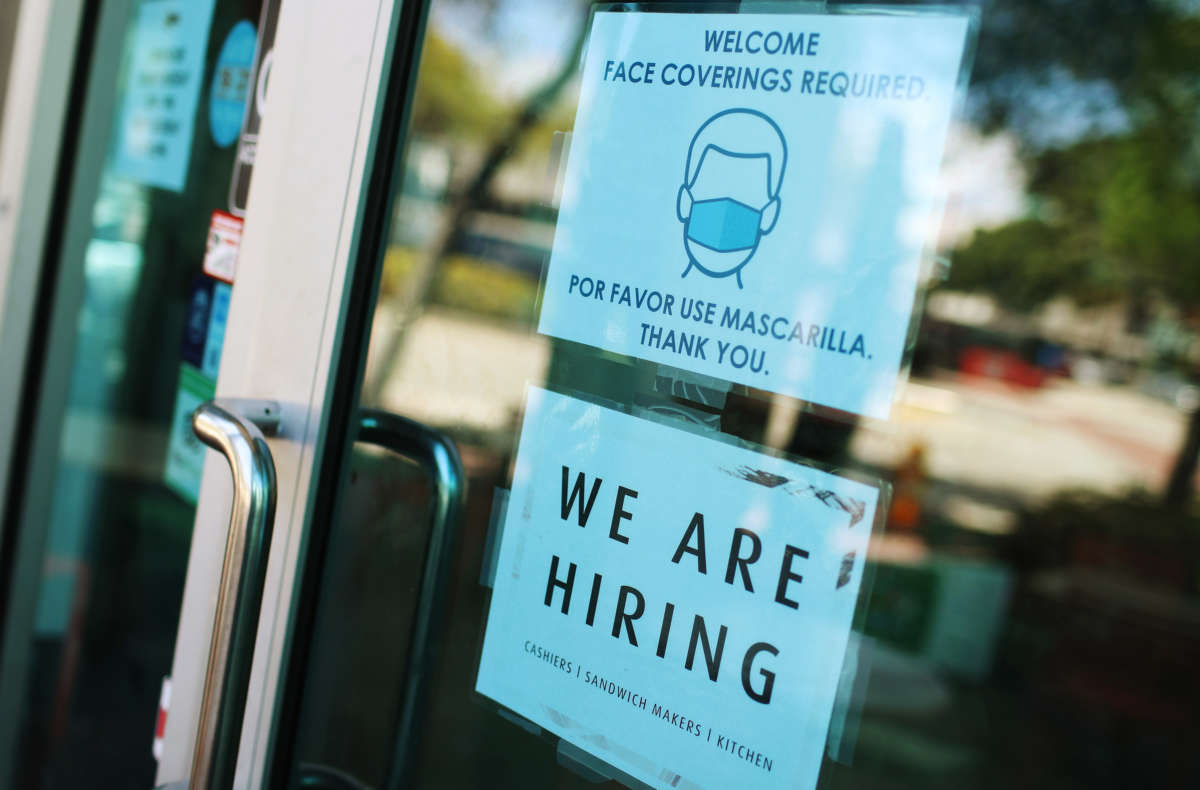The March employment reports show the economy bouncing back sharply due to the spread of vaccines and the first effects of the Biden recovery package. The establishment survey showed the economy adding 916,000 jobs in the month. The household survey was also encouraging, with the unemployment rate dropping 0.2 percentage points to 6.0 percent, a level not reached in the recovery from the Great Recession until September of 2014. The employment-to-population ratio (EPOP) also edged up 0.2 percentage points to 57.8 percent.
Gains Were Broadly Based
The benefits of the job growth were broadly shared. The unemployment rate for Black workers fell from 9.9 percent to 9.6 percent, while their EPOP rose from 54.2 percent to 54.9 percent, but this is still down 3.8 percentage points from its 2019 average. The EPOP for white workers was 58.1 percent in March, 2.9 percentage points below its 2019 average. The unemployment rate for Hispanic workers fell a 0.6 percentage point to 7.9 percent, while their EPOP rose a 0.5 percentage point to 60.4 percent.
By education group, workers without high school degrees and workers with just high school degrees saw the sharpest drops in unemployment, with their rates falling by 1.9 and 0.5 percentage points, respectively, to 8.2 percent and 6.7 percent. The unemployment rate for college grads fell a 0.1 percentage point to 3.7 percent, while the rate for those with some college was unchanged at 5.9 percent.
Asian Americans were an exception, with a rise in their unemployment rate of 0.9 percent to 6.0 percent, which is 0.6 percentage points above the 5.4 percent rate for whites. It typically is lower. Their EPOP of 59.4 percent is 2.9 percentage points below its 2019 average.
Women Did Slightly Better Than Men in March
The situation for women improved slightly more than for men in March, with a drop in their unemployment rate of a 0.2 percentage point to 5.9 percent, compared to a 0.1 percentage point drop for men to 6.2 percent. The labor force participation rates for both men and women are well below 2019 levels, with a drop of 1.3 percentage points for women to 56.1 percent and 1.9 percentage points for men to 67.3 percent.
Long-Term Unemployment Still Extraordinarily High
One item in the household survey that is discouraging is that the share of long-term unemployment (more than 26 weeks) rose again to 43.4 percent, approaching the all-time high of 45.2 percent in the Great Recession. This means many of the same people have been unemployed throughout the recession. Typically, unemployment is more widely shared with people experiencing short stretches.
The share of unemployed due to temporary layoffs fell to 20.8 percent. This is still high. In normal times this is in a range of 12.0–15.0 percent, but it’s far below the peak of 77.9 percent last April. The percent of the unemployed who voluntarily quit their job, a measure of labor market strength, rose from 7.0 to 8.0 percent. That’s up from a low of 2.5 percent in April, but still far below peak of more than 15.0 percent in 2019.
Jump in Incorporated Self-Employed
One interesting item in the household survey was a jump in the incorporated self-employed of 354,000 to 6,024,000. This was largely reversing a drop reported in February, but it left the number of people in this category of small business owners just 2.6 percent below the 2019 average.
Job Gains in Establishment Survey Broadly Based Across Sectors
With upward revisions to the prior two months data, this brings the average rate of job growth for the last three months to 539,000. Restaurants and state and local governments had the strongest gains, adding 175,800 and 129,000 jobs, respectively, but there were gains everywhere. The gains in restaurants reflect fewer restrictions and more people willing to go out after being vaccinated. State and local governments are bringing workers back as in person teaching resumes and they have a new infusion of money from the recovery package.
Construction added 110,000 jobs in March, more than reversing a weather-caused loss of 56,000 jobs in February. Manufacturing gained 53,000 jobs. Transportation added 47,500, while retail added 22,500.
Wage Growth Has Held Up Through the Recession
It seems that wage growth has continued largely at its pre-pandemic pace. The average hourly wage for production workers rose at 3.4 percent annual rate, comparing the last three months (January, February, March) with prior three months (October, November, December).

One very encouraging item in these data is it seems that productivity is still growing at a healthy pace. It grew at a 2.5 percent rate last year. With hours up around 2.5 percent in the first quarter, GDP is likely to be close to 6.0 percent. We are looking at another quarter of strong growth. This will allow for large wage gains without inflation.
On the whole, this is a very strong report. The growth in jobs is impressive as is the drop in the unemployment rate. But, we still have a very long way to go. We are down 8.4 million jobs since February of 2020. If we add in 1.8 million for the job growth we should have seen, that puts us down 10.2 million. It would take more than 11 months of job growth like March to make up this loss.
Thank you for reading Truthout. Before you leave, we must appeal for your support.
Truthout is unlike most news publications; we’re nonprofit, independent, and free of corporate funding. Because of this, we can publish the boldly honest journalism you see from us – stories about and by grassroots activists, reports from the frontlines of social movements, and unapologetic critiques of the systemic forces that shape all of our lives.
Monied interests prevent other publications from confronting the worst injustices in our world. But Truthout remains a haven for transformative journalism in pursuit of justice.
We simply cannot do this without support from our readers. At this time, we’re appealing to add 50 monthly donors in the next 2 days. If you can, please make a tax-deductible one-time or monthly gift today.
